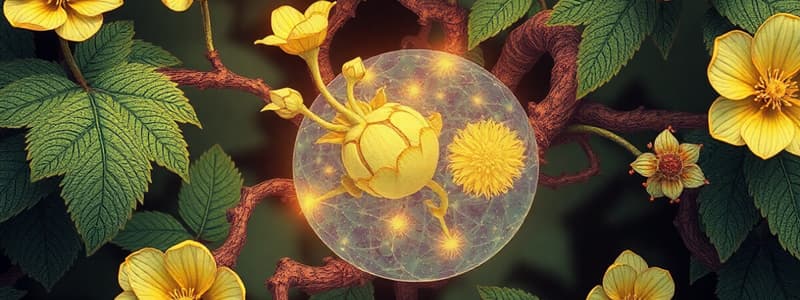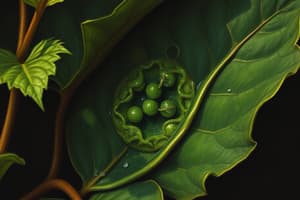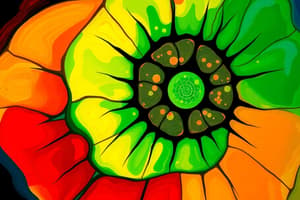Podcast
Questions and Answers
What is the primary role of chlorophyll in photosynthesis?
What is the primary role of chlorophyll in photosynthesis?
- To convert sunlight into chemical energy (correct)
- To absorb carbon dioxide
- To release oxygen into the atmosphere
- To store glucose
Where do the light-dependent reactions of photosynthesis take place?
Where do the light-dependent reactions of photosynthesis take place?
- In the cell membrane
- In the cytoplasm
- In the stroma
- In the thylakoid membranes (correct)
Which of the following is produced during the light-dependent reactions?
Which of the following is produced during the light-dependent reactions?
- Carbon dioxide
- Glucose
- Water
- Oxygen (correct)
What is the significance of 'high-energy hydrogens' in the Calvin Cycle?
What is the significance of 'high-energy hydrogens' in the Calvin Cycle?
What compound is formed as a result of the overall photosynthesis process?
What compound is formed as a result of the overall photosynthesis process?
Which part of the chloroplast is the gel-filled matrix surrounding the thylakoids?
Which part of the chloroplast is the gel-filled matrix surrounding the thylakoids?
What is necessary for photosynthesis to occur?
What is necessary for photosynthesis to occur?
What are grana in the chloroplasts?
What are grana in the chloroplasts?
Which equation represents the overall process of photosynthesis?
Which equation represents the overall process of photosynthesis?
What are the two main types of reactions that occur during photosynthesis?
What are the two main types of reactions that occur during photosynthesis?
What is the primary function of the thylakoids within the chloroplasts?
What is the primary function of the thylakoids within the chloroplasts?
Which part of the chloroplast is responsible for carrying out the reactions of the Calvin Cycle?
Which part of the chloroplast is responsible for carrying out the reactions of the Calvin Cycle?
What molecules are split during the light-dependent reactions of photosynthesis?
What molecules are split during the light-dependent reactions of photosynthesis?
Which of these is a product of the light-dependent reactions?
Which of these is a product of the light-dependent reactions?
What role do chlorophyll pigments play in photosynthesis?
What role do chlorophyll pigments play in photosynthesis?
During photosynthesis, what is the primary energy source for the light-dependent reactions?
During photosynthesis, what is the primary energy source for the light-dependent reactions?
The required inputs for the dark reaction of photosynthesis include which of the following?
The required inputs for the dark reaction of photosynthesis include which of the following?
What is produced as a result of the light-independent reactions?
What is produced as a result of the light-independent reactions?
Which statement accurately describes the thylakoids?
Which statement accurately describes the thylakoids?
What is the result of the overall photosynthesis equation?
What is the result of the overall photosynthesis equation?
Flashcards
Photosynthesis
Photosynthesis
The process by which plants use light energy to convert carbon dioxide and water into glucose (sugar) and oxygen.
Chlorophyll
Chlorophyll
A green pigment found in chloroplasts that absorbs light energy for photosynthesis.
Thylakoids
Thylakoids
Coin-shaped membranes inside chloroplasts containing chlorophyll.
Grana
Grana
Signup and view all the flashcards
Stroma
Stroma
Signup and view all the flashcards
Light-dependent reaction
Light-dependent reaction
Signup and view all the flashcards
Light-independent reaction
Light-independent reaction
Signup and view all the flashcards
Calvin Cycle
Calvin Cycle
Signup and view all the flashcards
Glucose
Glucose
Signup and view all the flashcards
Oxygen
Oxygen
Signup and view all the flashcards
What is photosynthesis?
What is photosynthesis?
Signup and view all the flashcards
What is chlorophyll?
What is chlorophyll?
Signup and view all the flashcards
What are thylakoids?
What are thylakoids?
Signup and view all the flashcards
What are grana?
What are grana?
Signup and view all the flashcards
What is the stroma?
What is the stroma?
Signup and view all the flashcards
What is the light-dependent reaction?
What is the light-dependent reaction?
Signup and view all the flashcards
What is the light-independent reaction?
What is the light-independent reaction?
Signup and view all the flashcards
What is the Calvin Cycle?
What is the Calvin Cycle?
Signup and view all the flashcards
What is glucose?
What is glucose?
Signup and view all the flashcards
What is oxygen?
What is oxygen?
Signup and view all the flashcards
Study Notes
Photosynthesis Overview
- Photosynthesis is the process plants use to produce food from light.
- The process occurs in chloroplasts within plant cells.
- The overall equation for photosynthesis is 6CO₂ + 6H₂O → 6O₂ + C₆H₁₂O₆ (glucose)
Chloroplast Structure
- Chloroplasts are the site of photosynthesis.
- Contain thylakoids, which are coin-shaped membranes.
- Thylakoids contain chlorophyll, a pigment that absorbs light. Different types of chlorophyll exist.
- Grana – stacks of thylakoids, work together to carry out reactions.
- Stroma – the gel-filled matrix surrounding the thylakoids.
- The stroma is the site of the light-independent reactions.
Photosynthesis Stages
- Photosynthesis occurs in two main stages: light-dependent reactions and the light-independent/Calvin cycle.
Light-Dependent Reactions
- Occur in the thylakoid membranes.
- Water molecules are split, releasing oxygen (O₂).
- Light energy excites chlorophyll molecules.
- Hydrogen atoms are boosted to higher energy levels, and they're sent to the dark reaction. These high energy hydrogens are combined with NADP+ to form NADPH.
- ATP and NADPH are produced.
Light-Independent Reactions (Calvin Cycle)
- Occur in the stroma.
- High-energy hydrogens from the light reaction combine with carbon dioxide (CO₂).
- The Calvin Cycle uses ATP and NADPH generated in the light-dependent reactions.
- Produces glucose (a sugar).
Studying That Suits You
Use AI to generate personalized quizzes and flashcards to suit your learning preferences.




